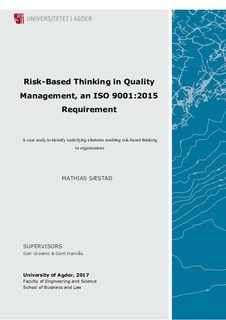| dc.description.abstract | Issues and Purpose
One of the most significant changes in ISO 9001:2015 versus ISO 9001:2008 is the increased
focus on risk-based thinking (RBT) in requirements for planning, review and improvement of the
quality management system (QMS) and its processes. To enable RBT in organizations related to
the QMS, management must understand what RBT is, and have knowledge about the theoretical
foundation of the term. A theoretical foundation for RBT is found to be lacking in literature. This
is considered a significant challenge for management seeking to implement RBT with regards to
their QMS. Consequently, the objective of this study is to identify elements from quality and risk
management theories as a potential basis for RBT. Due to the positive implications that RBT
might have on improving an organization’s QMS this is considered an important area to address.
Scope and Limitations
The scope of this study is limited to identify underlying elements for RBT in organizations, and
conceptualize them in a model. The model is investigated in the context of a case company to
discuss the effects of implementing RBT for improving an organization’s QMS. Underlying
elements in the model and their interrelationships are discussed to some extent, but are not the
main purpose of this study.
Methods
A constructive research approach was used for this study, this is a method suitable for
developing models and other constructions that can contribute to theory in the field of research.
This included gathering qualitative data from multiple sources, such as literature and case study.
Most of the source material consisted of literature regarding topics such as; quality management,
risk management, systems theories, and the ISO 9000 family of standards. The data collected
from the case study was compared and discussed based on literature and the theoretical
framework. The findings were used to validate the potential basis for a foundation for RBT, as
presented in this thesis. Discussion
In order to propose a basis for a foundation regarding RBT I had to gain some insights into
quality and risk management. Characteristics emphasized in Total Quality Management (TQM)
and Enterprise Risk Management (ERM) were considered essential for RBT. Based on this, the
underlying elements for conducting RBT were identified as; Process, Organization, Culture,
Competence, and Management, referred to as the POCCM-model in this thesis. Arguably, other
elements could also be added to the model. However, in this thesis I found POCCM to be a
sufficient proposal as a foundation for RBT.
The POCCM-model provides a relevant contribution to better understand RBT and its
foundation. Findings demonstrate that the elements in POCCM-model are a good representation
of underlying elements in RBT. There is a correlation between the theories and characteristics
proposed as a potential foundation for RBT and the results from the case study. The POCCMmodel
was used to assess the current situation of case company’s QMS with regards to RBT.
This revealed that improvement of the elements in the organization related to the POCCM-model
would result in an overall improvement regarding RBT, leading to opportunities for improving
the QMS.
Evaluation
The POCCM-model is grounded in known theories and quality standards; TQM, ERM and ISO
9001:2015. Findings have demonstrated a positive alignment of the POCCM-model, RBT and
the theoretical framework. The findings are considered to be similar within other organizations in
Norway, based on culture and values. Consequently, the proposed model, or a similar model is
considered the most appropriate representation of the foundation concerning RBT. However,
there is a potential to describe the POCCM-model from a more practical perspective. Thus,
making it easier for organizations to implement RBT in their QMS | nb_NO |

